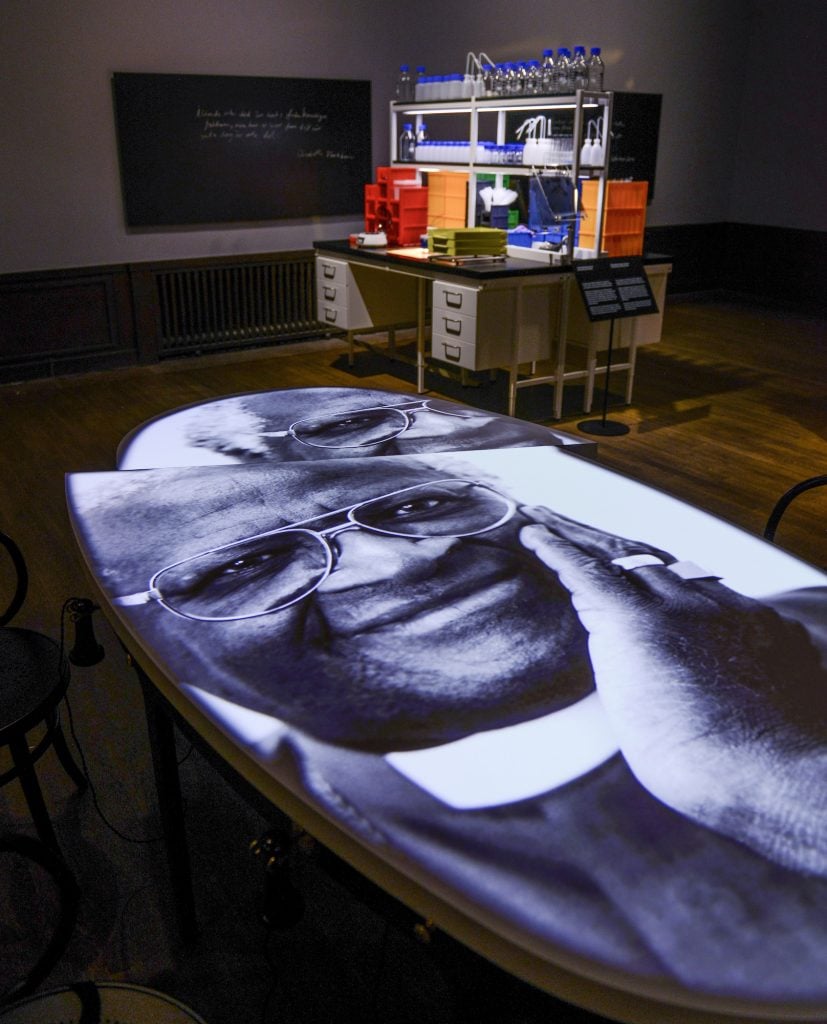How does it look when a person is shaping the ideas behind a literary classic, the discovery of black holes or the search for clues to the riddle of ageing? This work is depicted in the Nobel Prize Museum’s exhibition From Idea to Nobel Prize, which opens on Valentine’s Day, 14 February.
There is a long and demanding process behind every prize-awarded effort that has led to discoveries, ideas and stories which have changed the way we see ourselves and the world. In the exhibition From Idea to Nobel Prize, Annesofie Becker and Morten Søndergaard portray the efforts of nine Nobel Prize laureates through their working environments.
The role of desks and tables in exploring the world is easy to ignore. But at desks, laboratory benches, work tables and negotiating tables, objects and words are mixed together and unexpected relationships emerge.
“Many people have strong opinions about their desks. We ask why. In the exhibition we try to portray the importance of a desk in the working process, and how the desk itself can influence scientific and poetic results,” says Annesofie Becker.
On peace prize laureate Desmond Tutu’s desk, London-based photographer Jillian Edelstein displays images from her book Truth and Lies − depicting South Africa’s post-apartheid reconciliation process. Museum visitors can also listen to the voices of witnesses from the Truth and Reconciliation Commission that was led by Tutu. The broken shape of the table can be regarded as a symbol of how reconciliation and peace negotiations are all about trying to unite what has been destroyed.
On Swedish novelist Selma Lagerlöf’s desk is a cast of her hands, with which she wrote her books, while a typewriter stands on Colombia writer Gabriel García Márquez’s Spartan desk next to his footstool.
The exhibition From ideas to Nobel Prizes has previously been shown at Liljevalchs Art Gallery in Stockholm as part of the highly publicised exhibition Life Eternal.
The exhibition consists of six desks or tables, one for each prize category. The people highlighted in the exhibition are physics laureates Albert Einstein and Roger Penrose, medicine laureate Elizabeth Blackburn, literature laureates Selma Lagerlöf and Gabriel García Márquez, peace prize laureate Desmond Tutu, economic sciences laureates Esther Duflo and Abhijit Banerjee and chemistry laureate Marie Curie (who had previously shared a physics prize). The exhibition was designed by Birger Lipinski.
The exhibition will be on display at the Nobel Prize Museum between 14 February and 29 August 29, 2023.
On 17 February there will be a vernissage and official inauguration of the exhibition.
Annesofie Becker is a social anthropologist and curator. She works on an interdisciplinary basis and is interested in exhibitions as an independent art form. Major exhibition projects: Museum Europa, Memento Metropolis, Writing is an Act of Love, Øvelse gør mester. Most recently together with Morten Søndergaard: Sproghospitalet (Sorø Kunstmuseum) and Den nye hjørnestue (Bakkehusmuseet, Copenhagen). Currently curating the exhibition and performance Electricity at the National Gallery of Denmark (SMK) in Copenhagen.
Morten Søndergaard is first and foremost a poet but is also interested in the relationship between language and materiality. For example, he often works in marble and has done several exhibition projects. It can be said that Søndergaard marerialises language to experience it. He has translated both the Epic of Gilgamesh and the Persian poet Hafez. Søndergård’s poems and texts in Danish have been translated into numerous languages. Most recently, his highly publicised book Ordapotek (Word Pharmacy) − its title a reference to diagnostics and grammar − has also been published in Swedish (2022).
Jillian Edelstein works in both portrait and documentary photography. An Honourable Fellow of the Royal Photographic Society, her book Truth and Lies: Stories from South Africa’s Truth and Reconciliation Commission was published in 2002 and won the Kobal Book Award & the Visa D’Or. The National Portrait Gallery have collected over one hundred of her portraits. In 2018 she was Included in The Royal Photographic Society’s list of 100 International Photographic Heroines. Her documentary Water Rats, a series about cold swimming during Lockdown has won three Impact awards for commended feature documentary & for Creativity and Originality. Impossible Norman, is a feature documentary about the BiPolar afflicted, Academy Award nominated American screenwriter, Norman Wexler; final filming is underway.
Birger Lipinski is an interior architect (SIR/MSA) whose work focuses mainly on exhibition design. He is interested in activating the relationship between visitors and thematics, objects and spatialities, often in temporary environments. He has previously collaborated with Stockholm’s Performing Arts Museum, Moderna Museet, the Mediterranean Museum, the Swedish Exhibitions Agency, Malmö Museums and several county museums around Sweden.
